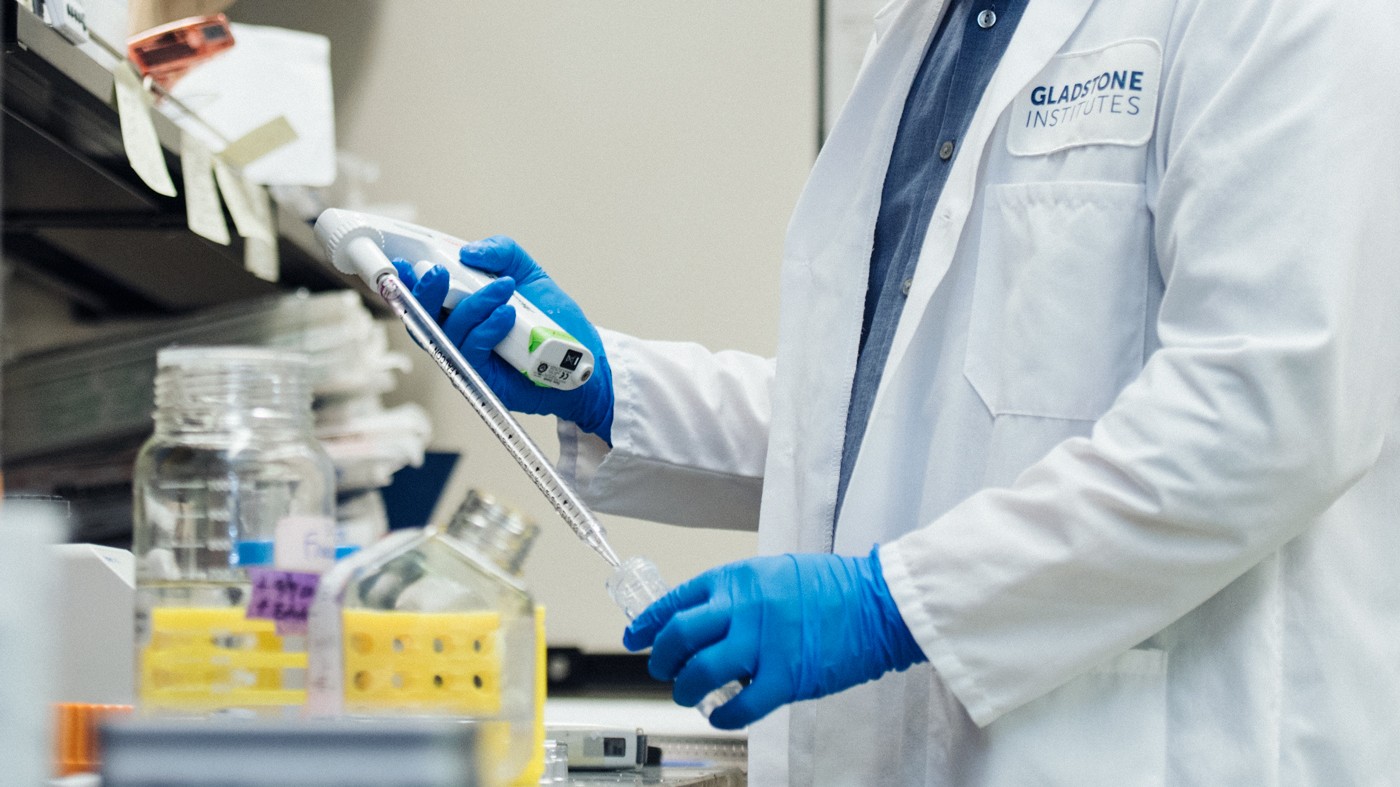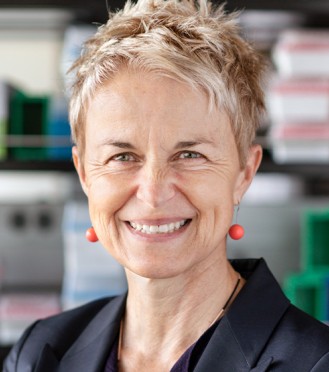Gladstone NOW: The Campaign Join Us on the Journey✕

Gladstone virologists explain why immunity is not so straightforward, what it means to be immune to a coronavirus, and how immunity is shaping our current pandemic landscape.
The number of COVID-19 infections around the world is once again falling, this time in the wake of the Omicron variant of the virus. People everywhere have their fingers crossed that the current combination of vaccines and widespread infections with Omicron mean that we are protected from future surges of COVID-19. But immunity is not so straightforward—it can change over time and vary between people.
We asked three Gladstone virologists—Warner Greene, MD, PhD, director of the Michael Hulton Center for HIV Cure Research at Gladstone Institutes, Melanie Ott, MD, PhD, director of the Gladstone Institute of Virology, and Nadia Roan, PhD, an associate investigator at Gladstone—what it means to be immune to a coronavirus, how immunity is shaping our current pandemic landscape, and what comes next for COVID-19 immunity. Here’s what you should know.
1. The human body has two kinds of immune responses.
To understand the nuances of COVID-19 immunity, you need to know that the human immune system has different ways of fighting off invading pathogens. Innate immune responses are the first line of defense, and are relatively non-specific; innate immunity is activated in response to most viruses, bacteria, or other foreign components.
“Innate immunity is the most primitive form of immunity, but it’s very, very important,” says Greene. “In the early days of the COVID-19 pandemic, this was the only thing we could depend upon to initially protect us from the virus.”
The adaptive immune system, on the other hand, kicks into gear more slowly after exposure to a virus. However, it produces antibodies and memory B and T cells that are specifically tuned to the virus. These virus-specific antibodies and cells stick around after the infection, protecting you from re-infection with the same illness again—at least for a while.
2. Immunity has many shades of gray.
“Immunity” might seem straightforward; you’re either immune to a virus or you’re not. But having antibodies and memory T cells against a pathogen isn’t a surefire guarantee that the virus or bacteria won’t cause any illness.
“Having immunity doesn’t mean that you can’t get sick,” says Roan. “It’s not that black and white. For COVID-19, it can mean that you get an asymptomatic infection, or a less severe infection than you would have otherwise. Your immunity might not be strong enough to prevent the virus from growing in your nose and airways, but it can prevent it from spreading to other organs and causing severe disease.”
Why is immunity not absolute? For one thing, virus and bacteria can evolve over time. An influenza infection or vaccine one year might not protect you against influenza a year or two later, because the virus has changed so much in that time frame that your adaptive immune system doesn’t recognize it anymore. For another thing, antibody levels against pathogens decrease over time.
3. Waning antibody levels doesn’t mean your immunity is gone.
“Typically after vaccination or infection, you’ll initially have very high levels of antibodies that can act quickly to prevent a virus from taking hold in your body,” says Roan. “But antibody levels fall over time. This is good; we don’t want high antibody levels to every pathogen we’ve ever encountered, because it would just completely overwhelm our immune system.”
These falling antibody levels are one reason that people are well-protected against COVID-19 immediately after infection or vaccination, but more susceptible again a few months later. Remember, however, that the adaptive immune system also includes T cells and antibody-generating B cells—which don’t fade as quickly as antibodies.
“Even when the antibodies disappear, the B cells persist,” says Roan. “When they’re called into action again, they essentially make more of themselves and then start producing antibodies.”
While antibodies that remain around after infection or vaccination act quickly against COVID-19, B cells are slower to rev up. This gives the coronavirus time to establish itself in a person’s body before the B cells begin producing antibodies against the virus.
4. Immunity from vaccines isn’t the same as immunity from COVID-19 infection.
Whether a person is infected with COVID-19 or receives a COVID-19 vaccine, their body is exposed to components of the coronavirus, and they develop antibodies and memory cells that can fend off the virus. But immunity from an infection isn’t the same as immunity from a vaccine.
When someone is infected with COVID-19, the virus enters their body through the respiratory tract. This means the immune response is centered around the respiratory system, where it leaves antibodies and memory cells ideally located to face the next infection. By contrast, most vaccines enter the body through the bloodstream, far from the nose and lungs; the antibodies and memory cells these vaccines elicit take some time to find their way to the airways.
Moreover, infected people are exposed to the full, infectious COVID-19 virus, while people who receive a vaccine are exposed to only select bits of the virus. As a result, vaccinated people generate a narrower collection of memory T cells against the virus than infected people do.
At the same time, however, since researchers can control the dose and timing of vaccines, they’re able to optimize the memory cells that are generated in response to vaccination. Furthermore, vaccination is designed to elicit immunity under optimal conditions, in contrast to infection where the virus has evolved ways to dampen some signals that promote effective immunity.
“The goal of vaccination shouldn’t be to simply achieve immunity equivalent to that elicited by the virus itself, but to surpass it, and there are rational ways to try to do this,” says Roan.
To date, however, scientists still aren’t sure whether vaccination or SARS-CoV-2 infection leads to better, longer-lived immunity.
5. Even if you’ve had COVID-19, you should still get vaccinated for maximum immunity.
One thing that most researchers agree on: Right now, the people best protected from COVID-19 are those who have hybrid immunity—they have been infected with the virus, and also have been fully vaccinated and boosted.
“If you’re unvaccinated and become infected with COVID-19, you get some protection against a later infection, but it’s usually not very strong and not very broad—it might not protect you against new variants,” says Ott. “If you’re vaccinated and have a breakthrough infection, it’s a totally different story. The infection will not only be less severe, but once again boost your pre-existing immunity, which is currently active against most variants, for future infections.”
Essentially, with each vaccination and booster shot, you strengthen and further prepare your immune system for future infections—without the risks to your health that multiple infections would represent.
6. The timing of shots matters for immunity.
When COVID-19 vaccines were being developed, the priority was to protect as many people as possible, as quickly as possible, from getting severe disease and dying of the coronavirus. So, studies in the United States spaced out the first two doses of the vaccines by about a month. But evidence from other countries—where the timing of the doses was different—suggests that a longer gap between shots might be better.
“People who got more spaced-out vaccines actually had better immunity,” says Roan. “The immunological basis for this is that the initial immune response is still developing after 3–4 weeks, and immune cells are still maturing—meaning that B cells, for instance, have not yet reached their potential for generating high-quality antibodies.”
Many scientists also suspect that the longer spacing between the second dose and the booster shot also explains why most people have obtained the best immune response after the booster.
“When we rolled out the vaccines, the first and second shots were given as close together as possible to get the best initial protection,” says Ott. “But I think the fact that the third shot is coming 5–6 months later for most people is beneficial.”
7. We don’t know yet how long COVID-19 immunity lasts.
Even after a booster shot, COVID-19 immunity will wane; that’s in part because of the rapidly decreasing antibody levels. But the good news is that memory B and T cells will likely persist. For the first SARS virus, memory T cells seem capable of persisting for more than a decade. If that holds true for SARS-CoV-2, people will retain memory T cells against COVID-19 for years to come.
“When antibodies go down, infections start to go back up,” says Greene. “But hospitalization and death numbers don’t follow in those fully vaccinated and boosted individuals, and that’s because of the persistence of these memory B and T cells. It suggests that, as of right now, there’s really no benefit in a fourth dose for most people.”
The exceptions include the elderly and other people known to have a compromised immune system.
Researchers can’t, of course, predict whether a new variant of COVID-19 will arise that is so different it could completely evade existing immunity. In that case, a new vaccine might be necessary to convey immunity. It is also possible that B or T cells may begin to wane years from now.
“We really don’t know how long current immunity will last,” says Greene. “Will we have to vaccinate everyone again yearly, every 5 years, or every 10 years like tetanus? We just don’t know yet.”
8. Immunity varies between people.
Two people, both vaccinated against COVID-19, can be exposed to the same coronavirus at the same time, and one might avoid infection completely—or remain asymptomatic—while the other develops severe symptoms and ends up in the hospital.
“There are people in which the vaccines just don’t work as well,” says Greene. “This might be because they have a very mild immunodeficiency they’re not even aware of, or it might have to do with how much virus they were exposed to.”
The diversity in immunity between people makes it hard to say for sure who is protected against COVID-19 at any given time and who should receive a fourth booster dose of the vaccine to help increase their immunity.
The vast range of how people have acquired their immunity—between different types of vaccines, different strains of COVID-19, and different combinations thereof—also makes it hard to study current immunity.
“We have people who have had infections, we have people who have had vaccinations and infections, we have people who have been vaccinated—two, three, or four times,” says Ott. “It means there is this very diverse patchwork of immunity, and it has become hard to just compare vaccinated people to unvaccinated people.”
9. We may never reach herd immunity, and that’s okay. But high rates of immunity are still necessary.
Early in the days of the COVID-19 pandemic, there was a lot of talk of herd immunity—the concept that if enough people are immune to the virus, transmission might stop. Today, many researchers suspect that the end of the pandemic might not be signaled by true herd immunity, but by enough people having immunity that hospitalization and death numbers are under control.
“Herd immunity is kind of a moving target,” says Roan. “The level of immunity needed for herd immunity changes based on the variant and how infectious it is, along with other variables. We might need 75 percent of the population to be immune to reach herd immunity for one variant, and 90 percent for another variant.”
The fact that long-term immunity mostly prevents serious disease, rather than infection and transmission, also complicates herd immunity.
“I think we’re probably not going to reach complete herd immunity for two major reasons: vaccine hesitancy and the increasing infectivity of the variants,” says Greene. “But we may have sufficient community immunity that the COVID-19 pandemic will end and the virus will become endemic within our society. There will be brush fires of infection among the unvaccinated, but these will be controlled, especially with new antiviral medicines.”
It’s also important to remember that herd immunity does not have borders; it’s not sufficient for 90 percent of the population in one country to be immune if the virus is still circulating at high levels in a neighboring country where vaccination levels are much lower. The virus travels and crosses borders, along with the people who carry it.
“Coronaviruses don’t check in with Customs,” adds Greene. “As long as there are large pockets of free-roaming virus somewhere on the globe, we also continue to be at risk of a new variant emerging—one that could be more contagious or deadly than the ones we’ve already encountered. That’s why it’s important that we continue to vaccinate as many people as possible globally. COVID-19 is a worldwide problem, and our solution must be global as well.”
Support Our COVID-19 Research Efforts
Gladstone scientists are moving quickly to respond to the coronavirus outbreak. Help us end this pandemic.
Science in Seconds | Researchers Pinpoint Key Gene Behind Heart Defects in Down Syndrome
Science in Seconds | Researchers Pinpoint Key Gene Behind Heart Defects in Down Syndrome
In this video, Gladstone scientists share how they used stem cells, gene editing, and AI to identify a gene driving heart defects in Down syndrome—and how reducing its levels in mice restored normal heart development, offering hope for future treatments
Gladstone Experts Cardiovascular Disease Data Science and Biotechnology Pollard Lab Srivastava Lab AI Big Data CRISPR/Gene Editing Human Genetics Stem Cells/iPSCsScience in Seconds | The Thinking Microscope: Research Powered by an AI Brain
Science in Seconds | The Thinking Microscope: Research Powered by an AI Brain
In this video, Steve Finkbeiner and Jeremy Linsley showcase Gladstone’s groundbreaking “thinking microscope”—an AI-powered system that can design, conduct, and analyze experiments autonomously to uncover new insights into diseases like Alzheimer’s, Parkinson’s, and ALS.
Gladstone Experts ALS Alzheimer’s Disease Parkinson’s Disease Neurological Disease Finkbeiner Lab AI Big DataVisualizing Stem Cell Technology: An Animated Explainer
Visualizing Stem Cell Technology: An Animated Explainer
In this animated short, Deepak Srivastava explains how scientists can reprogram ordinary skin or blood cells back in time—turning them into induced pluripotent stem cells which are capable of becoming any cell type in the body.
Gladstone Experts Stem Cells/iPSCs






